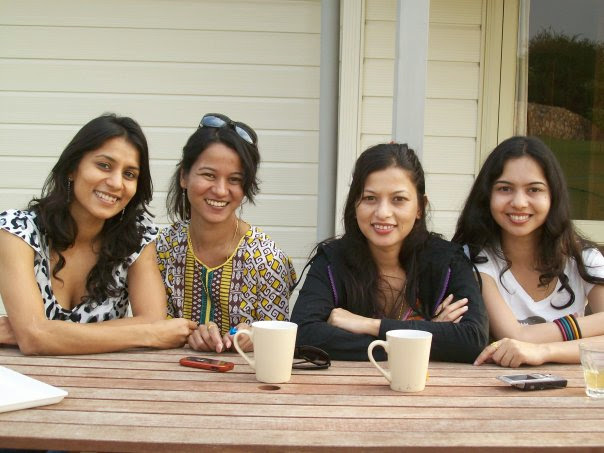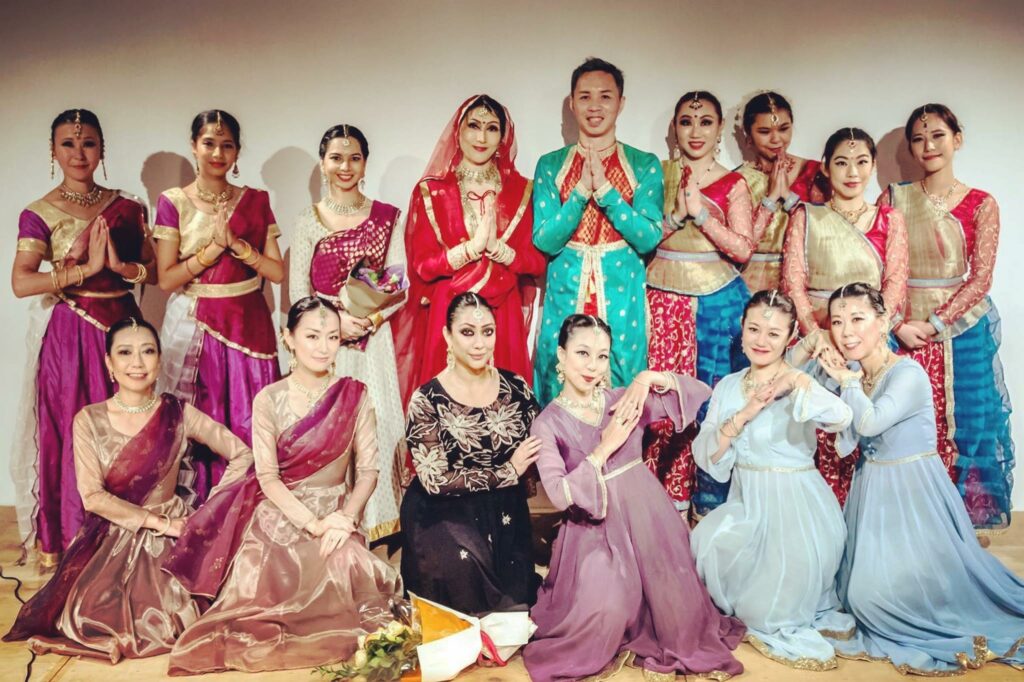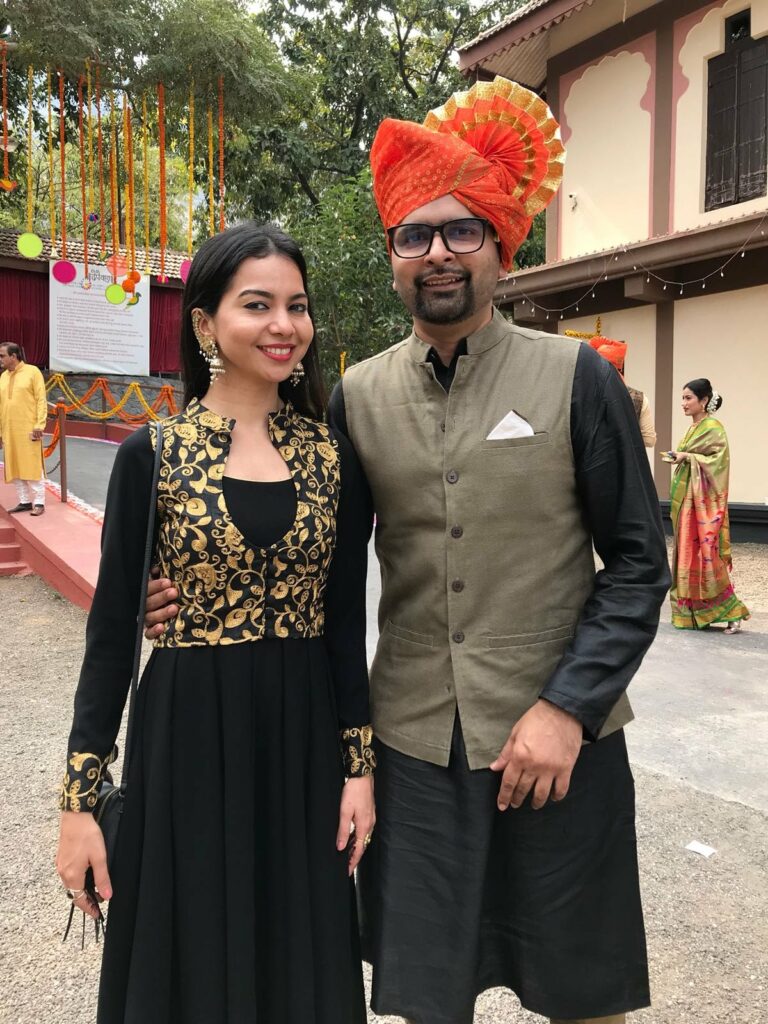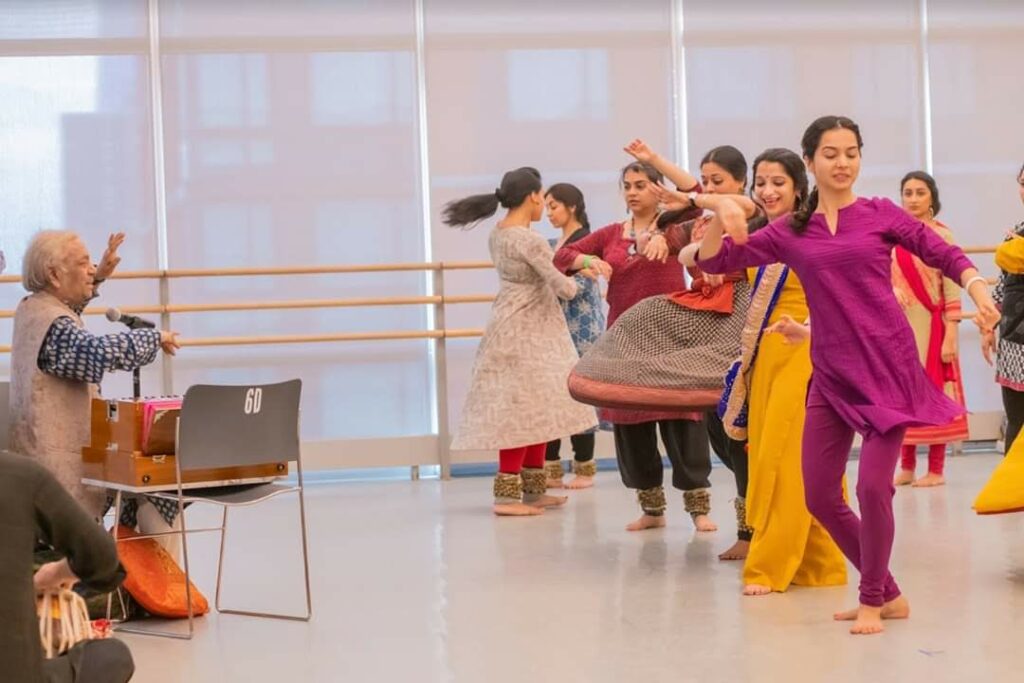“Dance is joy,” a tete-e-tete with Shivangi Dake Robert, Kathak faculty and senior dancer
By Vidhya Nair
“Dance is joy. Teaching children has been particularly joyful. I’m really enjoying it. They have a blank slate and absorb easily without inhibitions. It’s also a joy to teach passionate adults who are very keen to learn. Thanks to social media especially during this Covid19 pandemic it has been very useful to reach out and spread the art. It’s a small way to engage new audiences to Kathak. To spark an interest and makes them interested to come to a workshop and come to a class. It’s also a good space to learn from other people.” Says Kathak faculty of the Academy and senior dancer of Apsaras Arts Dance Company in this exclusive tete-e-tete with Vidhya Nair.















VN: Tell us about yourself. Your family background & how you came to learn, teach, perform Kathak?
SDR: I was born in Nagpur, Maharashtra. My interest in dance came early. According to my mother I was constantly dancing in front of the television or in my room from a very young age. My mother observed my interest and arranged for me to participate at the local Ganesh festival when I was 7. She saw potential in me and enrolled me for Kathak lessons with a well-known teacher in Nagpur – Guru Dr Sadhana Naphde, who incidentally my mother knew personally from her school days and they had a shared origin as their families originated from Gwalior, Madya Pradesh. My mother was interested in Hindustani classical music and we (including my three elder sisters) were encouraged to learn. From the age of 8, I began my Kathak journey with my Guruji Dr Sadhana Naphde and began to take annual exams as she was associated with Ghandarva Mahavidyalaya till I was 19. I completed both my Vishaarad and Alangkaar while at 12th year in school. Dance was a priority for me.
I performed very actively in Nagpur. At age 14, my Guruji sent me to a national level dance competition in Hyderabad hosted by Samskaar Bharati. My Guru travelled with me and it was my first time performing a solo. I won the 1st prize and that was the first time I began to consider pursuing Kathak seriously as a career. From that point, I had many travelling opportunities at Kathak competitions and performances around India.
The Gharana I belong to is mixed – it’s a combined style: Jaipur-Lucknow. We would learn as a group with a table artiste and my teacher would compose, write songs and I was privileged to witness the collaborative effort of artistes in creating a piece. It was a wonderful learning environment involving a lot of hard work and creative ideas. Learning like this is organic and impromptu – every lesson is new. My classmates and I performed at Ramnavmi, Janmashtami and other festivals. My mother was always there for my performances and often she would invite our housing colony friends to attend as well. By the early 2000s, I had the opportunity to perform on television – Zee Marathi in a popular dance reality show – “Eka Peksha Ek” – where I performed Kathak pieces in various music genres – traditional classical style, Bollywood and Remixed music. It was a good experience to learn how to perform in front of the camera and present diverse styles.
I completed my Masters in Fine Arts at the University of Nagpur at age 22 and by then had moved to Pune after I received the national scholarship in Kathak by the Ministry of Tourism & Culture, Government of India and received intensive advanced training under Guru Smt Shama Bhate. It was quite a busy period shuttling between Nagpur and Pune completed my masters and fulfilling my Kathak training.
I returned to Nagpur after the stint in Pune to teach Kathak to beginners alongside my Guruji. In 2008, I made the move to Mumbai to try to seek new opportunities. My parents were very supportive and by then, one of my sisters was already living in Mumbai. I began teaching Kathak at Nalanda Research Centre alongside another school in Mumbai for 5 years till 2013. It was very different from Nagpur. Mumbai had more diverse students exposed to the glamourous world of Bollywood and there are many established Kathak artistes there. It was not easy to get solo opportunities but I persevered by continuously participating in competitions which called for solo pieces. From the age of 16, I was a regular in Mumbai for Pandit Birju Maharajji’s annual workshops. There I learned in-depth the Lucknow gharana style and I was able to travel to Goa to be part of Maharajji’s ensemble for the International Film Festival (IFFI) where we performed his choreography at the opening ceremony. I was selected by Maharajji and Saswati didi (his disciple) to present a particular piece in a repeat performance in Delhi as part of Vasant Utsav. I have tremendous gratitude to my Guru Sadhanaji for her resourceful and encouragement and performed at the Khajuraho Dance Festival at 16 and even at the National Youth Festival at regional, zonal and national levels. It was here that I met my husband – Kunal Robert who was a participant in the western band category.
VN: When did you come to Singapore and come to be associated with Apsaras Arts?
SDR: After my marriage in 2012, my husband had a work opportunity which required us to move to Singapore and we transferred from Mumbai in 2015. I was certain that I would continue to dance and teach in Singapore and began looking for opportunities here. I first came to Apsaras Arts on the calling of Nayantara Parpia, their then-Kathak teacher who engaged me as their Kathak examiner. When Nayantara returned to India, Apsaras Arts hired me as their replacement and I have been here ever since. During this time, I was fortunate to meet Neila Mami when I joined. She was very sweet and supportive of Kathak. I remember her advising me to prioritise my dance passion even in marriage and after children. She was the kindest lady and one who understood artistes and I consider it a privilege and blessing to have met and interacted with her even though she knew me far less than most of my colleagues in Apsaras Arts. She would love & praise the duets that Mohanapriyan and I would do and she was keen we create more interactive pieces between Bharatanatyam and Kathak.
VN: What are some of your memorable performances in Kathak both in Singapore and overseas?
SDR: My first solo for sure at the competition in Hyderabad. Both my Guru and I worked very hard with live musicians so that will always be a special one for both of us. In Singapore, through Apsaras Arts, I have received many opportunities to perform – one of the memorable ones was “Nupur Lahari” presented under Darshana Series in 2018. Mohanapriyan approached me to perform a solo recital and I wanted to meet Apsaras Arts’s high standards. I worked really hard, used recorded materials to create this work. I received lots of encouragement from Aravinth anna, Priyan and the rest of the team. I got a standing ovation; it was a very emotional moment for me. I’m very grateful for this beautiful opportunity. In the same year, I performed at the SIFAS Festival of Arts and later at the New York Kathak Festival, my first foray to the West and performed as a solo artiste in front of Maharajji and Saswati didi which was a privilege.
VN: What has it been like teaching Kathak – share the challenges and joys?
SDR: Dance is joy. Teaching children has been particularly joyful. I’m really enjoying it. They have a blank slate and absorb easily without inhibitions. Its also a joy to teach passionate adults who are very keen to learn. Some of the challenges are about meeting expectations in Singapore – of parents especially. There is an expectation that after a few months of learning, they expect the student to be on stage. Unrealistic it is. Even the adult students sometimes have this expectation. I’m often puzzled by this as my own Kathak journey has been long. They need to understand the depth of this art and how much time and effort is actually involved well before a stage performance. Explaining this can be challenging. I love teaching so I take this in my stride.
I see interest in Kathak growing in Singapore. Thanks to Bollywood- the glamour of it on screen, iconic Madhuri Dixit is known to many, but for people with no background, it’s important to understand that this is a pure dance that requires commitment and dedication to fully imbibe and learn.
VN: How do you manage your own training and practice?
SDR: For me, dance is the solution to any problem I may face whether emotional or mental. My Riyaaz is very important to me. Regular practice gives me peace, it’s a meditative process. At the end of an hour of practice, I feel productive and positive and a sense of achievement.
Exercise is very important as we age. Doing workouts also releases negative energies and is essential. Diet is also very very important for a dancer. My husband and I are vegan so we have cut down on animal products and slowly it has been a transformative experience both internally and we see it in our appearance too. Stretching I should do more. In some movements it is necessary to have strong limbs. Going to the gym was something I started pre-Covid19. These days, I go for 4.5km runs to build stamina.
VN: Tell us more about the art of Kathak. Do you think that knowledge in Hindustani Music is essential to the practice of Kathak? What is particular about the aesthetic of Kathak? Do you enjoy all the gharanas in Kathak – Can you tell us unique aspects of the styles?
SDR: It is important to listen often to Hindustani classical music, by listening, you can understand and appreciate. I have been trained in Hindustani vocal for 5 years and it has been very useful. When pursuing Kathak professionally, the learning of Hindustani vocal will be important. Including the tabla. The role of the harmonium, tabla, sitar play a key role so the awareness and learning is essential.
The Kathak aesthetic for me – I go by my instinct, I do my research. Before creating a costume or choosing a colour, I always work on my ideas thoroughly. It’s also good to experiment depending on what is being performed. E.g., for a fusion piece, perhaps a pastel shade would be appropriate. I feel it’s very personal. I go with whatever I can carry well. The fitting is important. As a petite person, when I dance, my dance should stand out and the costume should enable this. It should match one’s personality to carry off. I like experimenting.
Kathak has 3 Gharanas – Lucknow: Nazakat is all about the grace in movement and expressions. The upper body, torso movements are very unique, subtle and abhinaya is sophisticated. Maharajji has created these Ginti -thihayis which is something to look forward. You can see expressive thihayis where we show the deer, bird within rhythmic patterns.
The Jaipur Gharana is famed for the emphasis on footwork which is fast paced, chakaars – 3-4 are taken at one go. Swift sharp movements. Bhajans are a highlight. The Benares Gharana style is totally different. The highlights are the chakaars, Akash brahmaris. Vishal Krishnas – sliding, jumps & the way Tabla is used.
You also get to hear different bols from every Gharana. Each one has something unique and special.
VN: What do you consider as important aspects in the learning and teaching of Kathak in developing cultural education?
SDR: Learning an artform whether dance or music is a discipline. It requires commitment, consistency, learn & immersing yourself fully, watching professionals in the field perform, building your appreciation and knowledge. There should be respect and faith in your teacher, patience, working hard on your craft are all life values learned through pursuit of the arts.
Indian classical arts and Indian culture go hand in hand. We express our culture through the performing arts. E.g., For Holi, you learn the story behind Holi. In Kathak, a piece on the story of Holi can be explained via our concepts, choreography, songs and expressions. People unfamiliar with Indian culture get to experience our festivals, our stories this way. Everything is interconnected.
VN: This month, your student Sindhu Achudan makes her debut in her/your first Kathak Manch Pravesh – Can you share details on the process of creating this repertoire with your student?
SDR: We started working on this repertoire 1.5 years ago. Covid caused the debut to be delayed. We started from scratch. There was no original structure but over time, we built on it. I decided to teach her something different, something I hadn’t done before or seen by our audience. I started her training with all the technical part then the Vandana, the first piece. It took a while. Sindhu would come in 1-2 times a week and we would build the repertoire together. It took a whole year because we only get to work on it in person. Sindhu has been very hardworking, practising at home, it shows when you see her perform. A lot of thought has gone into creating this performance. She has learned a new Thumri and Tharana this year and we have live music, one of the interesting parts of the show. We have a wonderful set of musicians who have been coming for practice for the last 2 months.
Sindhu having been a Bharatanatyam dancer for many years. It has helped her catch up and pick up quickly. Normally in 5-6 years its not possible to perform at this level. So, her dance training has helped. There is no reason for someone from outside the native culture to be afraid to learn or face barriers. Art has no limits and no restrictions but once you commit yourself, through this art, Sindhu has been able to learn the language and culture too even if it were unfamiliar to her previously.
VN: Who are your Kathak idols? How do you think this dance form evolved into the modern age?
SDR: First and foremost is Pandjit Birju Maharajji. I’ve always amazed to watch him perform. Today, even when he sits and performs with his eyes, its special. The way he creates and improvises on the spot. Aditi Mangaldas is another. She’s so amazing with her work. Her contemporary and Kathak amalgamation just blows my mind. Her energy, her movement. Even the simplest movements she will do with so much energy and beauty. I have learned so much from her through her workshops. There are of course so many others but I would like to mention Saswati did’s grace and performance. These are true masters.
VN: What do you think has been the Impact of social media on dance?
SDR: 2-3 years I thought differently but today inn this digital age, it is an interesting development. I find myself doing “shows” on Instagram even. Thanks to social media especially during this Covid19 pandemic it has been very useful to reach out and spread the art. I feel having a presence on social media is important but I don’t overthink about what others are doing on it. What is important is to get on the dance floor and practice. It is a platform to express myself and I love to share. Why not? It’s a small way to engage new audiences to Kathak. To spark an interest and makes them interested to come to a workshop and come to a class. It’s also a good space to learn from other people.
VN: In your opinion, how is the practice and teaching of Kathak in Singapore?
SDR: Students should have dedication, practice and commitment to the artform. That I see is lacking. Not across the board but majority lack this. This concerns me. When watching Sindhu perform at her Manch Pravesh, I can imagine queries from parents and students about their Manch Pravesh – how and when? It’s not something that can be achieved instantly. In Singapore, there is an expectation that much can be done easily, quickly but as a trained classical dancer, I do feel a culture shock as to how the expectations to be a full-fledged performer is possible in just 2-3 years? Its unrealistic. This attitude needs to change and the reality needs to be understood. Some balance has to be created between the teacher, parents and students. What is encouraging is there is a lot of enthusiasm for Kathak. To watch and perform Kathak. At Apsaras Arts, we do have great opportunities for students to perform – in annual student showcase, these are opportunities that students should seize and work towards a solo like a Manch Pravesh.









